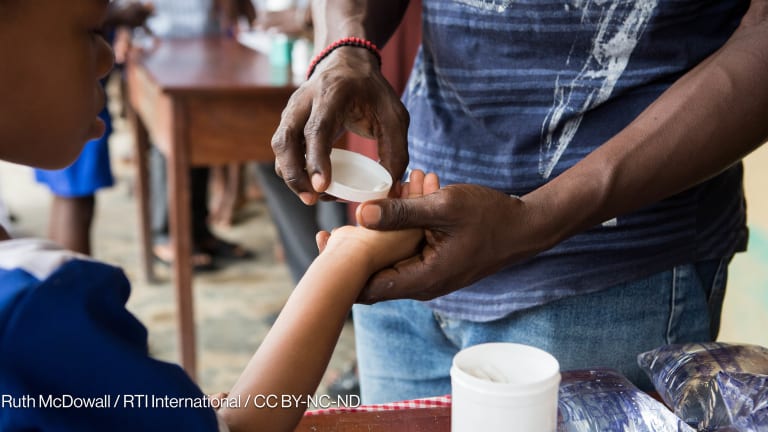USAID PPPs by the numbers
A leader in public-private partnerships for global development, USAID has inked more than 1,600 PPPs since 2001. Devex analysis of USAID's partnerships data reveals key trends in the agency's PPP portfolio — including its heavy focus on global health.
Over the past decade, donors across the board have been increasingly leveraging public-private partnerships as a tool to maximize the impact and increase the sustainability of their aid programming. In the global development context, PPPs are broadly defined as arrangements in which the public and private sectors combine resources and expertise to achieve development objectives. The world’s biggest bilateral donor, the U.S. Agency for the International Development was one of the first development agencies to embed PPPs into its foreign assistance model — a move that prompted praise from the Organization for Economic Cooperation and Development. PPPs were first integrated into the business systems of USAID in 2001, when the Bush administration created the Global Development Alliance initiative. Amid intense pressures on U.S. aid spending, the Obama administration’s USAID Forward reform agenda has set a goal of increasing PPP investments further to 10 percent of USAID mission program funding by fiscal 2015. Since the launch of GDA 13 years ago, USAID has inked more than 1,600 public-private partnerships valued at more than $20 billion. USAID estimates it has leveraged nearly $3 in partner contributions for every $1 of USAID funding. Strikingly, the agency’s just-released PPP data reveals new partnerships peaked in 2006 when USAID established 155 PPPs. USAID has established an average 100 PPPs in the years since. Devex dug deeper into USAID’s partnerships data to analyze key trends in the agency’s PPP portfolio. Here are three of our most important findings. One caveat to keep in mind is that USAID states that its data, while broadly representative of its PPP history, is not fully comprehensive; only 1,384 of the 1,600 USAID PPPs since 2001 are recorded. Heavy focus on global health Over the past decade, U.S. global health programs have claimed the lion’s share of USAID’s budget. That has also been the case for USAID’s public-private partnerships worldwide. The total value of USAID’s health PPPs since 2001 has reached $7.2 billion — just over half the agency’s PPP portfolio over that period. When USAID PPPs are counted individually, 285 of 1,384 USAID PPPs were in the health sector, behind the economic growth, trade and entrepreneurship sector’s 320 PPPs, which were on average of a considerably smaller value. Among the 10 largest USAID PPPs since 2001, six have been in the health sector. USAID’s single-largest PPP is the $4.2 billion Drug Donations for Neglected Tropical Diseases initiative (2006 to present) which counts four pharmaceutical giants as resource partners: GlaxoSmithKline, Johnson & Johnson, Merck & Co. and Pfizer. The U.S. government has contributed $386 million toward the global initiative — its single-largest investment in a USAID PPP. The Drug Donations for Neglected Tropical Diseases initiative has been the only USAID PPP to exceed $1 billion in total value; the average total value of a USAID PPP has been $11 million. Other USAID health PPPs exceeding $100 million include the $239 million Stop Tuberculosis Partnership (2001 to present), the $236 million African Program for Onchocerciasis Control (2001-2014), the $127 million Global Alliance for Tuberculosis Drug Development (2003-2008) and the $103 million Malaria Vaccine Development Program (2001-2010). Geographic spread is relatively more diversified By contrast, USAID data indicates that no single region dominates the agency’s PPP portfolio. In fact, PPPs that are global in scope claim the largest share (37 percent) of USAID’s total PPP value since 2001, ahead of those in sub-Saharan Africa (20 percent) and Latin America and Caribbean (16 percent). When USAID PPPs are counted individually, sub-Saharan Africa and Latin America and the Caribbean garner 390 and 373 PPPs, respectively, followed by Asia with 250. Colombia (100), South Africa (81), India (70), Georgia (62) and the Philippines (61) are the five countries with the largest number of USAID PPPs. While only 62 of 1,384 USAID PPPs since 2001 have been global in scope, three of these ranked among the 10 largest: the $4.2 billion Drug Donations for Neglected Tropical Diseases initiative (2006 to present), the $270 million Global Alliance for Clean Cookstoves (2010-2020) and the $127 million Global Alliance for Tuberculosis Drug Development (2003-2008). Noticeably, USAID has recorded only 47 partnerships in the Middle East and North Africa; these represent just 4 percent of the total value of USAID PPPs. The region, along with sub-Saharan Africa, has received the bulk of U.S. foreign aid over the past decade. Major US corporations emerge as top resource partners Finally, USAID data reveals that prominent, major U.S. corporations have emerged as USAID’s top resource partners for its PPPs since 2001. USAID data defines resource partners as organizations that commit financial or other resources to its PPPs. At the top of the leaderboard are Microsoft, which has 59 PPPs with USAID, followed by Coca-Cola (35), Chevron (32), Cisco Systems (26) and Intel (24). Unsurprisingly, these corporations have tended to ink USAID partnerships in sectors where they can leverage their experience and expertise. Microsoft, for instance, has had more PPPs with USAID in information and communication technology than any other sector. (See the slideshow above for a breakdown of these corporations’ geographic and sector engagement in USAID PPPs.) At the same time, it’s worth noting that firms and organizations from developing countries also figure prominently as resource partners in host countries across USAID’s PPP portfolio, including Colombia, the Philippines, Kenya and Georgia. Roughly half of the 100 largest USAID PPPs have had at least one developing country resource partner. For instance, the second-largest USAID PPP — the $656 million MIDAS Agribusiness program in Colombia — mobilized 87 percent of its resources from seven Colombian partners, including three Colombian banks. In addition to its resource partners, USAID has relied on implementing partners to execute about a tenth of its PPPs. Since 2001, USAID’s most frequent implementing partners have been CARE International, ACDI/VOCA, AED (which was acquired by FHI in 2011), PSI, DAI and CRS. Check out more insights and analysis provided to hundreds of Executive Members worldwide, and subscribe to the Development Insider to receive the latest news, trends and policies that influence your organization.
Over the past decade, donors across the board have been increasingly leveraging public-private partnerships as a tool to maximize the impact and increase the sustainability of their aid programming. In the global development context, PPPs are broadly defined as arrangements in which the public and private sectors combine resources and expertise to achieve development objectives.
The world’s biggest bilateral donor, the U.S. Agency for the International Development was one of the first development agencies to embed PPPs into its foreign assistance model — a move that prompted praise from the Organization for Economic Cooperation and Development.
PPPs were first integrated into the business systems of USAID in 2001, when the Bush administration created the Global Development Alliance initiative. Amid intense pressures on U.S. aid spending, the Obama administration’s USAID Forward reform agenda has set a goal of increasing PPP investments further to 10 percent of USAID mission program funding by fiscal 2015.
This story is forDevex Promembers
Unlock this story now with a 15-day free trial of Devex Pro.
With a Devex Pro subscription you'll get access to deeper analysis and exclusive insights from our reporters and analysts.
Start my free trialRequest a group subscription Printing articles to share with others is a breach of our terms and conditions and copyright policy. Please use the sharing options on the left side of the article. Devex Pro members may share up to 10 articles per month using the Pro share tool ( ).
Lorenzo is a former contributing analyst for Devex. Previously Devex's senior analyst for development finance in Manila.








